# Objective
Remove the `VerticalAlign` enum.
Text's alignment field should only affect the text's internal text alignment, not its position. The only way to control a `TextBundle`'s position and bounds should be through the manipulation of the constraints in the `Style` components of the nodes in the Bevy UI's layout tree.
`Text2dBundle` should have a separate `Anchor` component that sets its position relative to its transform.
Related issues: #676, #1490, #5502, #5513, #5834, #6717, #6724, #6741, #6748
## Changelog
* Changed `TextAlignment` into an enum with `Left`, `Center`, and `Right` variants.
* Removed the `HorizontalAlign` and `VerticalAlign` types.
* Added an `Anchor` component to `Text2dBundle`
* Added `Component` derive to `Anchor`
* Use `f32::INFINITY` instead of `f32::MAX` to represent unbounded text in Text2dBounds
## Migration Guide
The `alignment` field of `Text` now only affects the text's internal alignment.
### Change `TextAlignment` to TextAlignment` which is now an enum. Replace:
* `TextAlignment::TOP_LEFT`, `TextAlignment::CENTER_LEFT`, `TextAlignment::BOTTOM_LEFT` with `TextAlignment::Left`
* `TextAlignment::TOP_CENTER`, `TextAlignment::CENTER_LEFT`, `TextAlignment::BOTTOM_CENTER` with `TextAlignment::Center`
* `TextAlignment::TOP_RIGHT`, `TextAlignment::CENTER_RIGHT`, `TextAlignment::BOTTOM_RIGHT` with `TextAlignment::Right`
### Changes for `Text2dBundle`
`Text2dBundle` has a new field 'text_anchor' that takes an `Anchor` component that controls its position relative to its transform.
# Objective
- Allow rendering queue systems to use a `Res<PipelineCache>` even for queueing up new rendering pipelines. This is part of unblocking parallel execution queue systems.
## Solution
- Make `PipelineCache` internally mutable w.r.t to queueing new pipelines. Pipelines are no longer immediately updated into the cache state, but rather queued into a Vec. The Vec of pending new pipelines is then later processed at the same time we actually create the queued pipelines on the GPU device.
---
## Changelog
`PipelineCache` no longer requires mutable access in order to queue render / compute pipelines.
## Migration Guide
* Most usages of `resource_mut::<PipelineCache>` and `ResMut<PipelineCache>` can be changed to `resource::<PipelineCache>` and `Res<PipelineCache>` as long as they don't use any methods requiring mutability - the only public method requiring it is `process_queue`.
# Objective
Pipelines can be customized by wrapping an existing pipeline in a newtype and adding custom logic to its implementation of `SpecializedMeshPipeline::specialize`. To make that easier, the wrapped pipeline type needs to implement `Clone`.
For example, the current non-cloneable pipelines require wrapper pipelines to pull apart the wrapped pipeline like this:
```rust
impl FromWorld for Wireframe2dPipeline {
fn from_world(world: &mut World) -> Self {
let p = &world.resource::<Material2dPipeline<ColorMaterial>>();
Self {
mesh2d_pipeline: p.mesh2d_pipeline.clone(),
material2d_layout: p.material2d_layout.clone(),
vertex_shader: p.vertex_shader.clone(),
fragment_shader: p.fragment_shader.clone(),
}
}
}
```
## Solution
Derive or implement `Clone` on all built-in pipeline types. This is easy to do since they mostly just contain cheaply clonable reference-counted types.
---
## Changelog
Implement `Clone` for all pipeline types.
# Objective
Speed up the render phase of rendering. Simplify the trait structure for render commands.
## Solution
- Merge `EntityPhaseItem` into `PhaseItem` (`EntityPhaseItem::entity` -> `PhaseItem::entity`)
- Merge `EntityRenderCommand` into `RenderCommand`.
- Add two associated types to `RenderCommand`: `RenderCommand::ViewWorldQuery` and `RenderCommand::WorldQuery`.
- Use the new associated types to construct two `QueryStates`s for `RenderCommandState`.
- Hoist any `SQuery<T>` fetches in `EntityRenderCommand`s into the aformentioned two queries. Batch fetch them all at once.
## Performance
`main_opaque_pass_3d` is slightly faster on `many_foxes` (427.52us -> 401.15us)
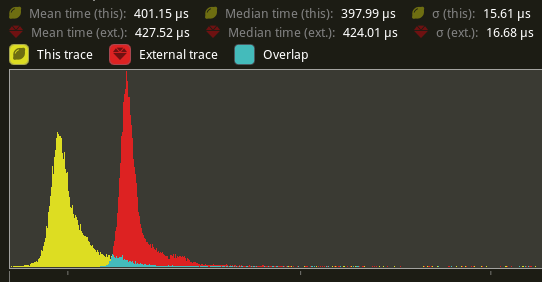
The shadow pass node is also slightly faster (344.52 -> 338.24us)
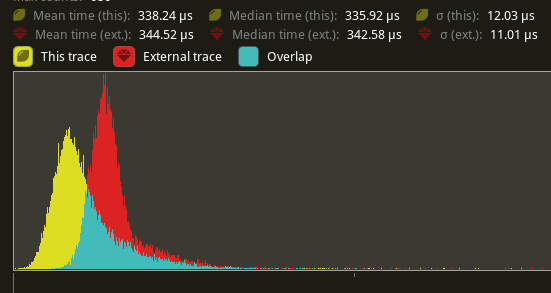
## Future Work
- Can we hoist the view level queries out of the core loop?
---
## Changelog
Added: `PhaseItem::entity`
Added: `RenderCommand::ViewWorldQuery` associated type.
Added: `RenderCommand::ItemorldQuery` associated type.
Added: `Draw<T>::prepare` optional trait function.
Removed: `EntityPhaseItem` trait
## Migration Guide
TODO
# Objective
- Describe the objective or issue this PR addresses.
SpritePipelineKey could use more constification.
## Solution
Constify SpritePipelineKey implementation.
## Changelog
Co-authored-by: AxiomaticSemantics <117950168+AxiomaticSemantics@users.noreply.github.com>
# Objective
- Every usage of `DrawFunctionsInternals::get_id()` was followed by a `.unwrap()`. which just adds boilerplate.
## Solution
- Introduce a fallible version of `DrawFunctionsInternals::get_id()` and use it where possible.
- I also took the opportunity to improve the error message a little in the case where it fails.
---
## Changelog
- Added `DrawFunctionsInternals::id()`
# Objective
One of the use-cases for the function `Entity::from_raw` is creating placeholder entity ids, which are meant to be overwritten later. If we use a constant for this instead of `from_raw`, it is more ergonomic and self-documenting.
## Solution
Add a constant that returns an entity ID with an index of `u32::MAX` and a generation of zero. Users are instructed to overwrite this value before using it.
# Objective
- shaders defs can now have a `bool` or `int` value
- `#if SHADER_DEF <operator> 3`
- ok if `SHADER_DEF` is defined, has the correct type and pass the comparison
- `==`, `!=`, `>=`, `>`, `<`, `<=` supported
- `#SHADER_DEF` or `#{SHADER_DEF}`
- will be replaced by the value in the shader code
---
## Migration Guide
- replace `shader_defs.push(String::from("NAME"));` by `shader_defs.push("NAME".into());`
- if you used shader def `NO_STORAGE_BUFFERS_SUPPORT`, check how `AVAILABLE_STORAGE_BUFFER_BINDINGS` is now used in Bevy default shaders
# Objective
- Closes#5262
- Fix color banding caused by quantization.
## Solution
- Adds dithering to the tonemapping node from #3425.
- This is inspired by Godot's default "debanding" shader: https://gist.github.com/belzecue/
- Unlike Godot:
- debanding happens after tonemapping. My understanding is that this is preferred, because we are running the debanding at the last moment before quantization (`[f32, f32, f32, f32]` -> `f32`). This ensures we aren't biasing the dithering strength by applying it in a different (linear) color space.
- This code instead uses and reference the origin source, Valve at GDC 2015
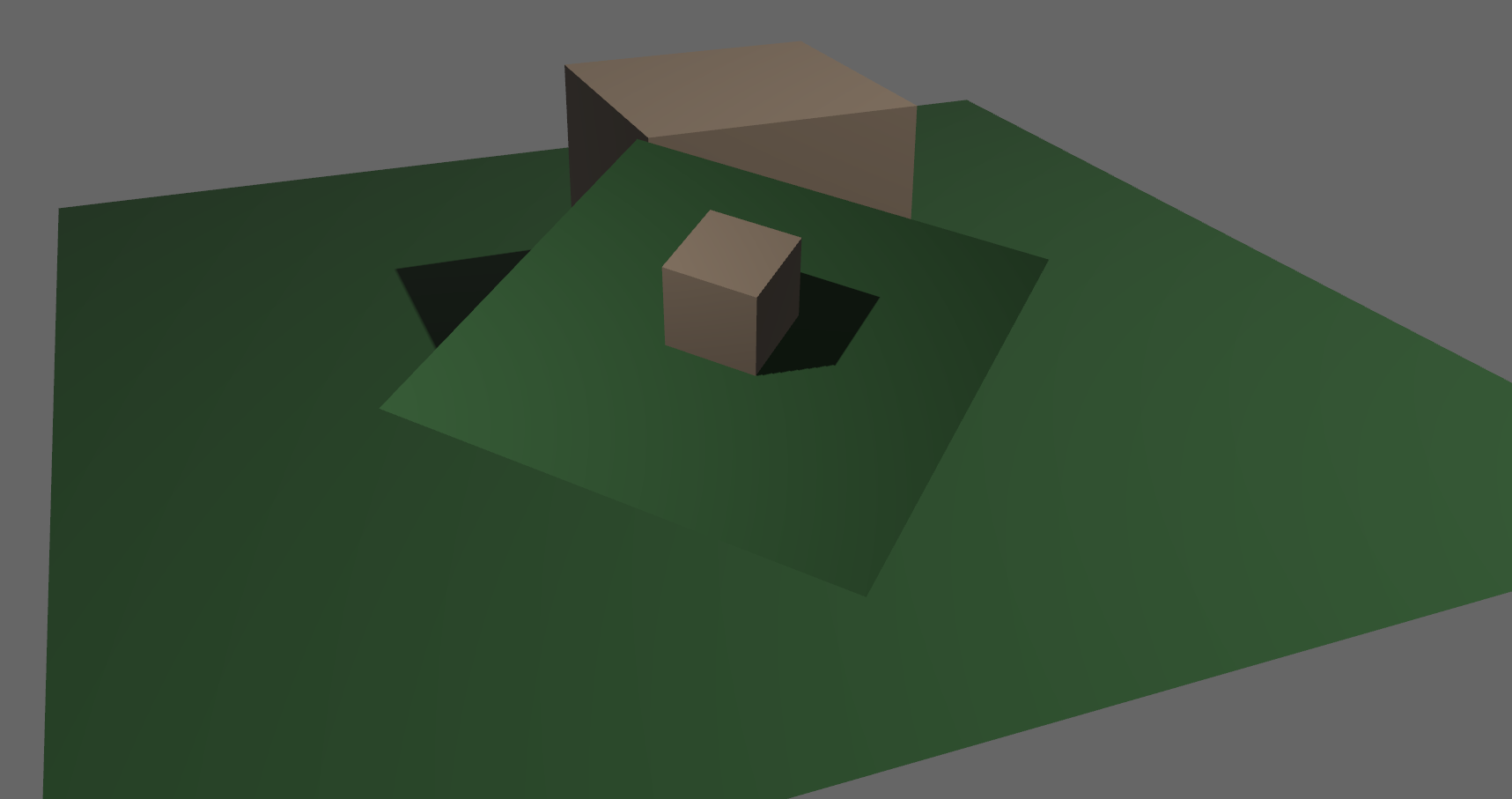
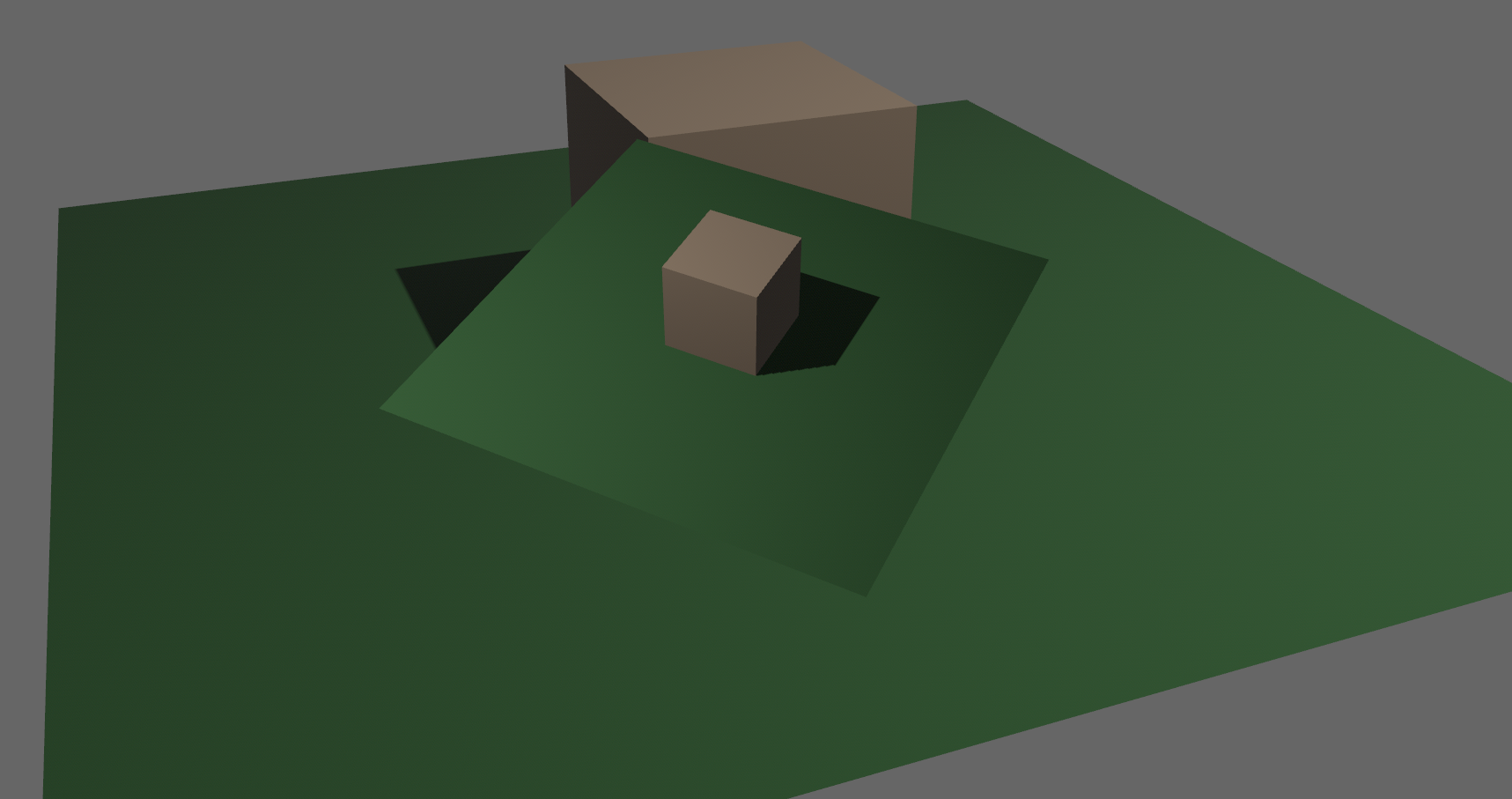
## Additional Notes
Real time rendering to standard dynamic range outputs is limited to 8 bits of depth per color channel. Internally we keep everything in full 32-bit precision (`vec4<f32>`) inside passes and 16-bit between passes until the image is ready to be displayed, at which point the GPU implicitly converts our `vec4<f32>` into a single 32bit value per pixel, with each channel (rgba) getting 8 of those 32 bits.
### The Problem
8 bits of color depth is simply not enough precision to make each step invisible - we only have 256 values per channel! Human vision can perceive steps in luma to about 14 bits of precision. When drawing a very slight gradient, the transition between steps become visible because with a gradient, neighboring pixels will all jump to the next "step" of precision at the same time.
### The Solution
One solution is to simply output in HDR - more bits of color data means the transition between bands will become smaller. However, not everyone has hardware that supports 10+ bit color depth. Additionally, 10 bit color doesn't even fully solve the issue, banding will result in coherent bands on shallow gradients, but the steps will be harder to perceive.
The solution in this PR adds noise to the signal before it is "quantized" or resampled from 32 to 8 bits. Done naively, it's easy to add unneeded noise to the image. To ensure dithering is correct and absolutely minimal, noise is adding *within* one step of the output color depth. When converting from the 32bit to 8bit signal, the value is rounded to the nearest 8 bit value (0 - 255). Banding occurs around the transition from one value to the next, let's say from 50-51. Dithering will never add more than +/-0.5 bits of noise, so the pixels near this transition might round to 50 instead of 51 but will never round more than one step. This means that the output image won't have excess variance:
- in a gradient from 49 to 51, there will be a step between each band at 49, 50, and 51.
- Done correctly, the modified image of this gradient will never have a adjacent pixels more than one step (0-255) from each other.
- I.e. when scanning across the gradient you should expect to see:
```
|-band-| |-band-| |-band-|
Baseline: 49 49 49 50 50 50 51 51 51
Dithered: 49 50 49 50 50 51 50 51 51
Dithered (wrong): 49 50 51 49 50 51 49 51 50
```


You can see from above how correct dithering "fuzzes" the transition between bands to reduce distinct steps in color, without adding excess noise.
### HDR
The previous section (and this PR) assumes the final output is to an 8-bit texture, however this is not always the case. When Bevy adds HDR support, the dithering code will need to take the per-channel depth into account instead of assuming it to be 0-255. Edit: I talked with Rob about this and it seems like the current solution is okay. We may need to revisit once we have actual HDR final image output.
---
## Changelog
### Added
- All pipelines now support deband dithering. This is enabled by default in 3D, and can be toggled in the `Tonemapping` component in camera bundles. Banding is a graphical artifact created when the rendered image is crunched from high precision (f32 per color channel) down to the final output (u8 per channel in SDR). This results in subtle gradients becoming blocky due to the reduced color precision. Deband dithering applies a small amount of noise to the signal before it is "crunched", which breaks up the hard edges of blocks (bands) of color. Note that this does not add excess noise to the image, as the amount of noise is less than a single step of a color channel - just enough to break up the transition between color blocks in a gradient.
Co-authored-by: Carter Anderson <mcanders1@gmail.com>
# Objective
- Fixes#4019
- Fix lighting of double-sided materials when using a negative scale
- The FlightHelmet.gltf model's hose uses a double-sided material. Loading the model with a uniform scale of -1.0, and comparing against Blender, it was identified that negating the world-space tangent, bitangent, and interpolated normal produces incorrect lighting. Discussion with Morten Mikkelsen clarified that this is both incorrect and unnecessary.
## Solution
- Remove the code that negates the T, B, and N vectors (the interpolated world-space tangent, calculated world-space bitangent, and interpolated world-space normal) when seeing the back face of a double-sided material with negative scale.
- Negate the world normal for a double-sided back face only when not using normal mapping
### Before, on `main`, flipping T, B, and N
<img width="932" alt="Screenshot 2022-08-22 at 15 11 53" src="https://user-images.githubusercontent.com/302146/185965366-f776ff2c-cfa1-46d1-9c84-fdcb399c273c.png">
### After, on this PR
<img width="932" alt="Screenshot 2022-08-22 at 15 12 11" src="https://user-images.githubusercontent.com/302146/185965420-8be493e2-3b1a-4188-bd13-fd6b17a76fe7.png">
### Double-sided material without normal maps
https://user-images.githubusercontent.com/302146/185988113-44a384e7-0b55-4946-9b99-20f8c803ab7e.mp4
---
## Changelog
- Fixed: Lighting of normal-mapped, double-sided materials applied to models with negative scale
- Fixed: Lighting and shadowing of back faces with no normal-mapping and a double-sided material
## Migration Guide
`prepare_normal` from the `bevy_pbr::pbr_functions` shader import has been reworked.
Before:
```rust
pbr_input.world_normal = in.world_normal;
pbr_input.N = prepare_normal(
pbr_input.material.flags,
in.world_normal,
#ifdef VERTEX_TANGENTS
#ifdef STANDARDMATERIAL_NORMAL_MAP
in.world_tangent,
#endif
#endif
in.uv,
in.is_front,
);
```
After:
```rust
pbr_input.world_normal = prepare_world_normal(
in.world_normal,
(material.flags & STANDARD_MATERIAL_FLAGS_DOUBLE_SIDED_BIT) != 0u,
in.is_front,
);
pbr_input.N = apply_normal_mapping(
pbr_input.material.flags,
pbr_input.world_normal,
#ifdef VERTEX_TANGENTS
#ifdef STANDARDMATERIAL_NORMAL_MAP
in.world_tangent,
#endif
#endif
in.uv,
);
```
This reverts commit 53d387f340.
# Objective
Reverts #6448. This didn't have the intended effect: we're now getting bevy::prelude shown in the docs again.
Co-authored-by: Alejandro Pascual <alejandro.pascual.pozo@gmail.com>
# Objective
- Right now re-exports are completely hidden in prelude docs.
- Fixes#6433
## Solution
- We could show the re-exports without inlining their documentation.
# Objective
Fixes#6059, changing all incorrect occurrences of ``id`` in the ``entity`` module to ``index``:
* struct level documentation,
* ``id`` struct field,
* ``id`` method and its documentation.
## Solution
Renaming and verifying using CI.
Co-authored-by: Edvin Kjell <43633999+Edwox@users.noreply.github.com>
# Objective
Bevy still has many instances of using single-tuples `(T,)` to create a bundle. Due to #2975, this is no longer necessary.
## Solution
Search for regex `\(.+\s*,\)`. This should have found every instance.
# Objective
- fix new clippy lints before they get stable and break CI
## Solution
- run `clippy --fix` to auto-fix machine-applicable lints
- silence `clippy::should_implement_trait` for `fn HandleId::default<T: Asset>`
## Changes
- always prefer `format!("{inline}")` over `format!("{}", not_inline)`
- prefer `Box::default` (or `Box::<T>::default` if necessary) over `Box::new(T::default())`
# Objective
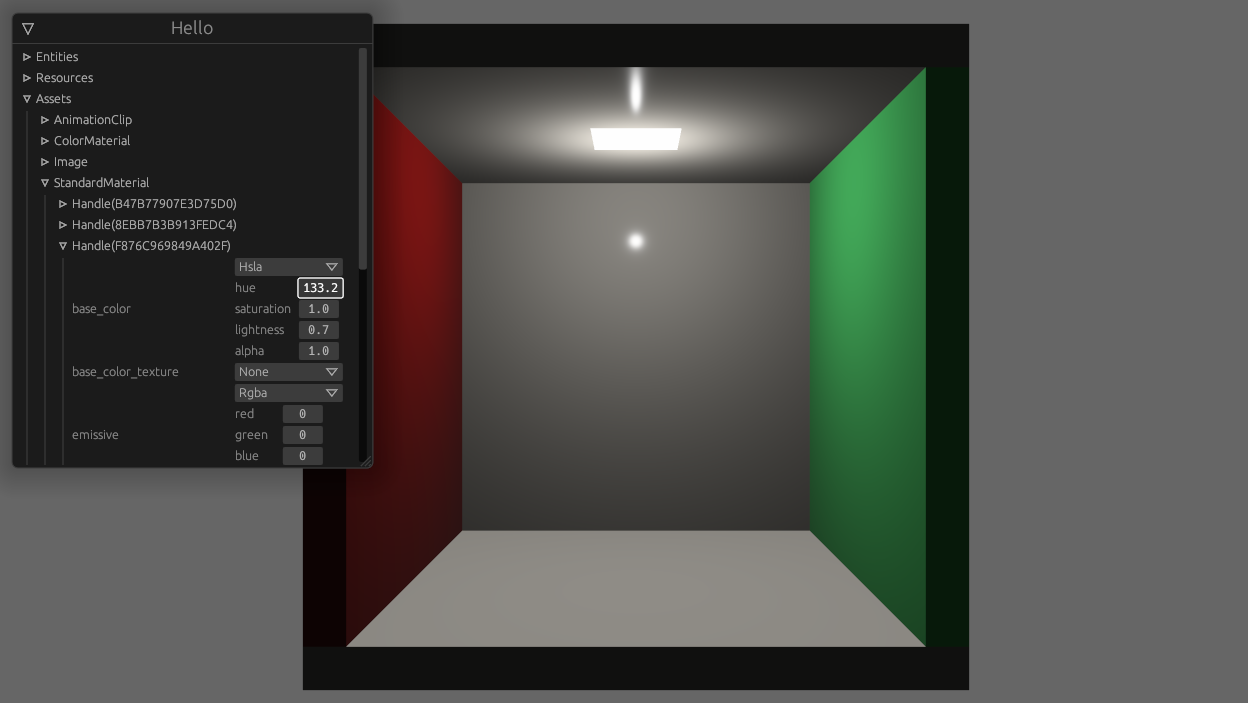
^ enable this
Concretely, I need to
- list all handle ids for an asset type
- fetch the asset as `dyn Reflect`, given a `HandleUntyped`
- when encountering a `Handle<T>`, find out what asset type that handle refers to (`T`'s type id) and turn the handle into a `HandleUntyped`
## Solution
- add `ReflectAsset` type containing function pointers for working with assets
```rust
pub struct ReflectAsset {
type_uuid: Uuid,
assets_resource_type_id: TypeId, // TypeId of the `Assets<T>` resource
get: fn(&World, HandleUntyped) -> Option<&dyn Reflect>,
get_mut: fn(&mut World, HandleUntyped) -> Option<&mut dyn Reflect>,
get_unchecked_mut: unsafe fn(&World, HandleUntyped) -> Option<&mut dyn Reflect>,
add: fn(&mut World, &dyn Reflect) -> HandleUntyped,
set: fn(&mut World, HandleUntyped, &dyn Reflect) -> HandleUntyped,
len: fn(&World) -> usize,
ids: for<'w> fn(&'w World) -> Box<dyn Iterator<Item = HandleId> + 'w>,
remove: fn(&mut World, HandleUntyped) -> Option<Box<dyn Reflect>>,
}
```
- add `ReflectHandle` type relating the handle back to the asset type and providing a way to create a `HandleUntyped`
```rust
pub struct ReflectHandle {
type_uuid: Uuid,
asset_type_id: TypeId,
downcast_handle_untyped: fn(&dyn Any) -> Option<HandleUntyped>,
}
```
- add the corresponding `FromType` impls
- add a function `app.register_asset_reflect` which is supposed to be called after `.add_asset` and registers `ReflectAsset` and `ReflectHandle` in the type registry
---
## Changelog
- add `ReflectAsset` and `ReflectHandle` types, which allow code to use reflection to manipulate arbitrary assets without knowing their types at compile time
Attempt to make features like bloom https://github.com/bevyengine/bevy/pull/2876 easier to implement.
**This PR:**
- Moves the tonemapping from `pbr.wgsl` into a separate pass
- also add a separate upscaling pass after the tonemapping which writes to the swap chain (enables resolution-independant rendering and post-processing after tonemapping)
- adds a `hdr` bool to the camera which controls whether the pbr and sprite shaders render into a `Rgba16Float` texture
**Open questions:**
- ~should the 2d graph work the same as the 3d one?~ it is the same now
- ~The current solution is a bit inflexible because while you can add a post processing pass that writes to e.g. the `hdr_texture`, you can't write to a separate `user_postprocess_texture` while reading the `hdr_texture` and tell the tone mapping pass to read from the `user_postprocess_texture` instead. If the tonemapping and upscaling render graph nodes were to take in a `TextureView` instead of the view entity this would almost work, but the bind groups for their respective input textures are already created in the `Queue` render stage in the hardcoded order.~ solved by creating bind groups in render node
**New render graph:**
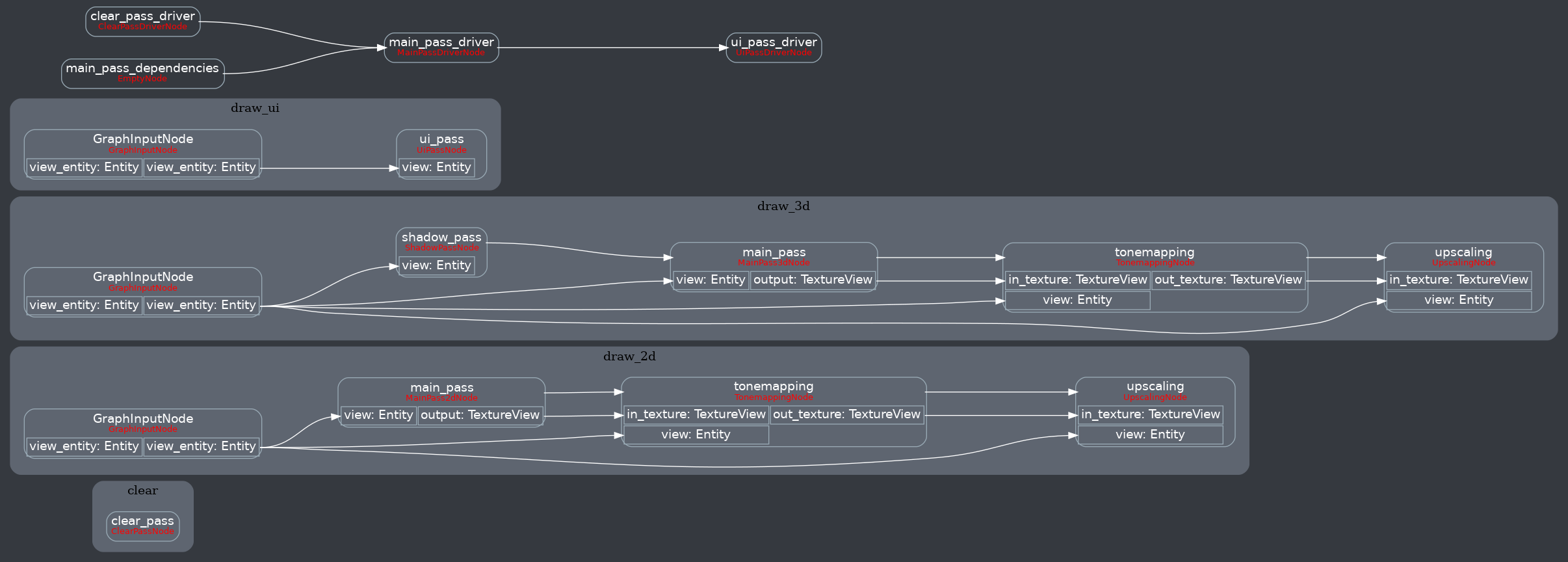
<details>
<summary>Before</summary>
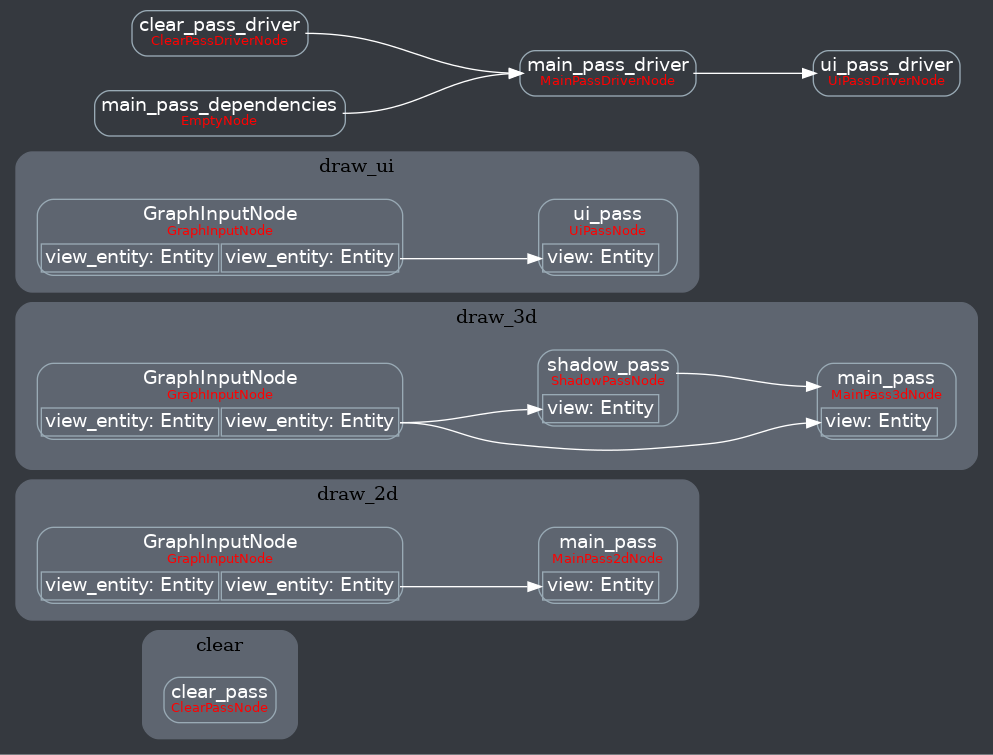
</details>
Co-authored-by: Carter Anderson <mcanders1@gmail.com>
See commit message.
I noticed I couldn't use `globals.time` when using `Material2d`.
I copied the solution from 8073362039 , and now `Material2d` works for me.
Perhaps some of these struct definitions could be shared in the future, but for now I've just copy pasted it (it looked like the `View` struct was done that way).
Ping @IceSentry , I saw a comment on the linked commit that you intended to do this work at some point in the future.
# Objective
- It's possible to create a mesh without positions or normals, but currently bevy forces these attributes to be present on any mesh.
## Solution
- Don't assume these attributes are present and add a shader defs for each attributes
- I updated 2d and 3d meshes to use the same logic.
---
## Changelog
- Meshes don't require any attributes
# Notes
I didn't update the pbr.wgsl shader because I'm not sure how to handle it. It doesn't really make sense to use it without positions or normals.
The docs ended up quite verbose :v
Also added a missing `#[inline]` to `GlobalTransform::mul_transform`.
I'd say this resolves#5500
# Migration Guide
`Transform::mul_vec3` has been renamed to `transform_point`.
Co-authored-by: devil-ira <justthecooldude@gmail.com>
# Objective
There is no Srgb support on some GPU and display protocols with `winit` (for example, Nvidia's GPUs with Wayland). Thus `TextureFormat::bevy_default()` which returns `Rgba8UnormSrgb` or `Bgra8UnormSrgb` will cause panics on such platforms. This patch will resolve this problem. Fix https://github.com/bevyengine/bevy/issues/3897.
## Solution
Make `initialize_renderer` expose `wgpu::Adapter` and `first_available_texture_format`, use the `first_available_texture_format` by default.
## Changelog
* Fixed https://github.com/bevyengine/bevy/issues/3897.
# Objective
Allow `Mesh2d` shaders to work with meshes that have vertex tangents
## Solution
Correctly pass `mesh.model` into `mesh2d_tangent_local_to_world`
# Objective
- Field `id` of `Handle<T>` is public: https://docs.rs/bevy/latest/bevy/asset/struct.Handle.html#structfield.id
- Changing the value of this field doesn't make sense as it could mean changing the previous handle without dropping it, breaking asset cleanup detection for the old handle and the new one
## Solution
- Make the field private, and add a public getter
Opened after discussion in #6171. Pinging @zicklag
---
## Migration Guide
- If you were accessing the value `handle.id`, you can now do so with `handle.id()`
# Objective
The [Stageless RFC](https://github.com/bevyengine/rfcs/pull/45) involves allowing exclusive systems to be referenced and ordered relative to parallel systems. We've agreed that unifying systems under `System` is the right move.
This is an alternative to #4166 (see rationale in the comments I left there). Note that this builds on the learnings established there (and borrows some patterns).
## Solution
This unifies parallel and exclusive systems under the shared `System` trait, removing the old `ExclusiveSystem` trait / impls. This is accomplished by adding a new `ExclusiveFunctionSystem` impl similar to `FunctionSystem`. It is backed by `ExclusiveSystemParam`, which is similar to `SystemParam`. There is a new flattened out SystemContainer api (which cuts out a lot of trait and type complexity).
This means you can remove all cases of `exclusive_system()`:
```rust
// before
commands.add_system(some_system.exclusive_system());
// after
commands.add_system(some_system);
```
I've also implemented `ExclusiveSystemParam` for `&mut QueryState` and `&mut SystemState`, which makes this possible in exclusive systems:
```rust
fn some_exclusive_system(
world: &mut World,
transforms: &mut QueryState<&Transform>,
state: &mut SystemState<(Res<Time>, Query<&Player>)>,
) {
for transform in transforms.iter(world) {
println!("{transform:?}");
}
let (time, players) = state.get(world);
for player in players.iter() {
println!("{player:?}");
}
}
```
Note that "exclusive function systems" assume `&mut World` is present (and the first param). I think this is a fair assumption, given that the presence of `&mut World` is what defines the need for an exclusive system.
I added some targeted SystemParam `static` constraints, which removed the need for this:
``` rust
fn some_exclusive_system(state: &mut SystemState<(Res<'static, Time>, Query<&'static Player>)>) {}
```
## Related
- #2923
- #3001
- #3946
## Changelog
- `ExclusiveSystem` trait (and implementations) has been removed in favor of sharing the `System` trait.
- `ExclusiveFunctionSystem` and `ExclusiveSystemParam` were added, enabling flexible exclusive function systems
- `&mut SystemState` and `&mut QueryState` now implement `ExclusiveSystemParam`
- Exclusive and parallel System configuration is now done via a unified `SystemDescriptor`, `IntoSystemDescriptor`, and `SystemContainer` api.
## Migration Guide
Calling `.exclusive_system()` is no longer required (or supported) for converting exclusive system functions to exclusive systems:
```rust
// Old (0.8)
app.add_system(some_exclusive_system.exclusive_system());
// New (0.9)
app.add_system(some_exclusive_system);
```
Converting "normal" parallel systems to exclusive systems is done by calling the exclusive ordering apis:
```rust
// Old (0.8)
app.add_system(some_system.exclusive_system().at_end());
// New (0.9)
app.add_system(some_system.at_end());
```
Query state in exclusive systems can now be cached via ExclusiveSystemParams, which should be preferred for clarity and performance reasons:
```rust
// Old (0.8)
fn some_system(world: &mut World) {
let mut transforms = world.query::<&Transform>();
for transform in transforms.iter(world) {
}
}
// New (0.9)
fn some_system(world: &mut World, transforms: &mut QueryState<&Transform>) {
for transform in transforms.iter(world) {
}
}
```
This is an adoption of #3775
This merges `TextureAtlas` `from_grid_with_padding` into `from_grid` , adding optional padding and optional offset.
Since the orignal PR, the offset had already been added to from_grid_with_padding through #4836
## Changelog
- Added `padding` and `offset` arguments to `TextureAtlas::from_grid`
- Removed `TextureAtlas::from_grid_with_padding`
## Migration Guide
`TextureAtlas::from_grid_with_padding` was merged into `from_grid` which takes two additional parameters for padding and an offset.
```
// 0.8
TextureAtlas::from_grid(texture_handle, Vec2::new(24.0, 24.0), 7, 1);
// 0.9
TextureAtlas::from_grid(texture_handle, Vec2::new(24.0, 24.0), 7, 1, None, None)
// 0.8
TextureAtlas::from_grid_with_padding(texture_handle, Vec2::new(24.0, 24.0), 7, 1, Vec2::new(4.0, 4.0));
// 0.9
TextureAtlas::from_grid(texture_handle, Vec2::new(24.0, 24.0), 7, 1, Some(Vec2::new(4.0, 4.0)), None)
```
Co-authored-by: olefish <88390729+oledfish@users.noreply.github.com>
# Objective
Now that we can consolidate Bundles and Components under a single insert (thanks to #2975 and #6039), almost 100% of world spawns now look like `world.spawn().insert((Some, Tuple, Here))`. Spawning an entity without any components is an extremely uncommon pattern, so it makes sense to give spawn the "first class" ergonomic api. This consolidated api should be made consistent across all spawn apis (such as World and Commands).
## Solution
All `spawn` apis (`World::spawn`, `Commands:;spawn`, `ChildBuilder::spawn`, and `WorldChildBuilder::spawn`) now accept a bundle as input:
```rust
// before:
commands
.spawn()
.insert((A, B, C));
world
.spawn()
.insert((A, B, C);
// after
commands.spawn((A, B, C));
world.spawn((A, B, C));
```
All existing instances of `spawn_bundle` have been deprecated in favor of the new `spawn` api. A new `spawn_empty` has been added, replacing the old `spawn` api.
By allowing `world.spawn(some_bundle)` to replace `world.spawn().insert(some_bundle)`, this opened the door to removing the initial entity allocation in the "empty" archetype / table done in `spawn()` (and subsequent move to the actual archetype in `.insert(some_bundle)`).
This improves spawn performance by over 10%:

To take this measurement, I added a new `world_spawn` benchmark.
Unfortunately, optimizing `Commands::spawn` is slightly less trivial, as Commands expose the Entity id of spawned entities prior to actually spawning. Doing the optimization would (naively) require assurances that the `spawn(some_bundle)` command is applied before all other commands involving the entity (which would not necessarily be true, if memory serves). Optimizing `Commands::spawn` this way does feel possible, but it will require careful thought (and maybe some additional checks), which deserves its own PR. For now, it has the same performance characteristics of the current `Commands::spawn_bundle` on main.
**Note that 99% of this PR is simple renames and refactors. The only code that needs careful scrutiny is the new `World::spawn()` impl, which is relatively straightforward, but it has some new unsafe code (which re-uses battle tested BundlerSpawner code path).**
---
## Changelog
- All `spawn` apis (`World::spawn`, `Commands:;spawn`, `ChildBuilder::spawn`, and `WorldChildBuilder::spawn`) now accept a bundle as input
- All instances of `spawn_bundle` have been deprecated in favor of the new `spawn` api
- World and Commands now have `spawn_empty()`, which is equivalent to the old `spawn()` behavior.
## Migration Guide
```rust
// Old (0.8):
commands
.spawn()
.insert_bundle((A, B, C));
// New (0.9)
commands.spawn((A, B, C));
// Old (0.8):
commands.spawn_bundle((A, B, C));
// New (0.9)
commands.spawn((A, B, C));
// Old (0.8):
let entity = commands.spawn().id();
// New (0.9)
let entity = commands.spawn_empty().id();
// Old (0.8)
let entity = world.spawn().id();
// New (0.9)
let entity = world.spawn_empty();
```
# Objective
Implement `IntoIterator` for `&Extract<P>` if the system parameter it wraps implements `IntoIterator`.
Enables the use of `IntoIterator` with an extracted query.
Co-authored-by: devil-ira <justthecooldude@gmail.com>
Very small change that improves the usability of `Sprite`.
Before this PR, the only way to render a portion of an `Image` was to create a `TextureAtlas` and use `TextureAtlasSprite`/`SpriteSheetBundle`. This can be very annoying for one-off use cases, like if you just want to remove a border from an image, or something. Using `Sprite`/`SpriteBundle` always meant that the entire full image would be rendered.
This PR adds an optional `rect` field to `Sprite`, allowing a sub-rectangle of the image to be rendered. This is similar to how texture atlases work, but does not require creating a texture atlas asset, making it much more convenient and efficient for quick one-off use cases.
Given how trivial this change is, it really felt like missing functionality in Bevy's sprites API. ;)
## Changelog
Added:
- `rect` field on `Sprite`: allows rendering a portion of the sprite's image; more convenient for one-off use cases, than creating a texture atlas.
# Objective
fixes#5946
## Solution
adjust cluster index calculation for viewport origin.
from reading point 2 of the rasterization algorithm description in https://gpuweb.github.io/gpuweb/#rasterization, it looks like framebuffer space (and so @bulitin(position)) is not meant to be adjusted for viewport origin, so we need to subtract that to get the right cluster index.
- add viewport origin to rust `ExtractedView` and wgsl `View` structs
- subtract from frag coord for cluster index calculation
While looking into `collide()`, I wrote some tests to confirm the behavior I read in the code. This PR adds those tests and improves the documentation.
Co-authored-by: robem <669201+robem@users.noreply.github.com>
# Objective
Promote the `Rect` utility of `sprite::Rect`, which defines a rectangle
by its minimum and maximum corners, to the `bevy_math` crate to make it
available as a general math type to all crates without the need to
depend on the `bevy_sprite` crate.
Fixes#5575
## Solution
Move `sprite::Rect` into `bevy_math` and fix all uses.
Implement `Reflect` for `Rect` directly into the `bevy_reflect` crate by
having `bevy_reflect` depend on `bevy_math`. This looks like a new
dependency, but the `bevy_reflect` was "cheating" for other math types
by directly depending on `glam` to reflect other math types, thereby
giving the illusion that there was no dependency on `bevy_math`. In
practice conceptually Bevy's math types are reflected into the
`bevy_reflect` crate to avoid a dependency of that crate to a "lower
level" utility crate like `bevy_math` (which in turn would make
`bevy_reflect` be a dependency of most other crates, and increase the
risk of circular dependencies). So this change simply formalizes that
dependency in `Cargo.toml`.
The `Rect` struct is also augmented in this change with a collection of
utility methods to improve its usability. A few uses cases are updated
to use those new methods, resulting is more clear and concise syntax.
---
## Changelog
### Changed
- Moved the `sprite::Rect` type into `bevy_math`.
### Added
- Added several utility methods to the `math::Rect` type.
## Migration Guide
The `bevy::sprite::Rect` type moved to the math utility crate as
`bevy::math::Rect`. You should change your imports from `use
bevy::sprite::Rect` to `use bevy::math::Rect`.
# Objective
- While generating https://github.com/jakobhellermann/bevy_reflect_ts_type_export/blob/main/generated/types.ts, I noticed that some types that implement `Reflect` did not register themselves
- `Viewport` isn't reflect but can be (there's a TODO)
## Solution
- register all reflected types
- derive `Reflect` for `Viewport`
## Changelog
- more types are not registered in the type registry
- remove `Serialize`, `Deserialize` impls from `Viewport`
I also decided to remove the `Serialize, Deserialize` from the `Viewport`, since they were (AFAIK) only used for reflection, which now is done without serde. So this is technically a breaking change for people who relied on that impl directly.
Personally I don't think that every bevy type should implement `Serialize, Deserialize`, as that would lead to a ton of code generation that mostly isn't necessary because we can do the same with `Reflect`, but if this is deemed controversial I can remove it from this PR.
## Migration Guide
- `KeyCode` now implements `Reflect` not as `reflect_value`, but with proper struct reflection. The `Serialize` and `Deserialize` impls were removed, now that they are no longer required for scene serialization.
# Objective
This PR changes it possible to use vertex colors without a texture using the bevy_sprite ColorMaterial.
Fixes#5679
## Solution
- Made multiplication of the output color independent of the COLOR_MATERIAL_FLAGS_TEXTURE_BIT bit
- Extended mesh2d_vertex_color_texture example to show off both vertex colors and tinting
Not sure if extending the existing example was the right call but it seems to be reasonable to me.
I couldn't find any tests for the shaders and I think adding shader testing would be beyond the scope of this PR. So no tests in this PR. 😬
Co-authored-by: Jonas Wagner <jonas@29a.ch>
*This PR description is an edited copy of #5007, written by @alice-i-cecile.*
# Objective
Follow-up to https://github.com/bevyengine/bevy/pull/2254. The `Resource` trait currently has a blanket implementation for all types that meet its bounds.
While ergonomic, this results in several drawbacks:
* it is possible to make confusing, silent mistakes such as inserting a function pointer (Foo) rather than a value (Foo::Bar) as a resource
* it is challenging to discover if a type is intended to be used as a resource
* we cannot later add customization options (see the [RFC](https://github.com/bevyengine/rfcs/blob/main/rfcs/27-derive-component.md) for the equivalent choice for Component).
* dependencies can use the same Rust type as a resource in invisibly conflicting ways
* raw Rust types used as resources cannot preserve privacy appropriately, as anyone able to access that type can read and write to internal values
* we cannot capture a definitive list of possible resources to display to users in an editor
## Notes to reviewers
* Review this commit-by-commit; there's effectively no back-tracking and there's a lot of churn in some of these commits.
*ira: My commits are not as well organized :')*
* I've relaxed the bound on Local to Send + Sync + 'static: I don't think these concerns apply there, so this can keep things simple. Storing e.g. a u32 in a Local is fine, because there's a variable name attached explaining what it does.
* I think this is a bad place for the Resource trait to live, but I've left it in place to make reviewing easier. IMO that's best tackled with https://github.com/bevyengine/bevy/issues/4981.
## Changelog
`Resource` is no longer automatically implemented for all matching types. Instead, use the new `#[derive(Resource)]` macro.
## Migration Guide
Add `#[derive(Resource)]` to all types you are using as a resource.
If you are using a third party type as a resource, wrap it in a tuple struct to bypass orphan rules. Consider deriving `Deref` and `DerefMut` to improve ergonomics.
`ClearColor` no longer implements `Component`. Using `ClearColor` as a component in 0.8 did nothing.
Use the `ClearColorConfig` in the `Camera3d` and `Camera2d` components instead.
Co-authored-by: Alice <alice.i.cecile@gmail.com>
Co-authored-by: Alice Cecile <alice.i.cecile@gmail.com>
Co-authored-by: devil-ira <justthecooldude@gmail.com>
Co-authored-by: Carter Anderson <mcanders1@gmail.com>
# Objective
- Similar to #5512 , the `View` struct definition in the shaders in `bevy_sprite` and `bevy_ui` were out of sync with the rust-side `ViewUniform`. Only `view_proj` was being used and is the first member and as those shaders are not customisable it makes little difference in practice, unlike for `Mesh2d`.
## Solution
- Sync shader `View` struct definition in `bevy_sprite` and `bevy_ui` with the correct definition that matches `ViewUniform`
# Objective
View mesh2d_view_types.wgsl was missing a couple of fields present in bevy::render::ViewUniform, causing rendering issues for shaders using later fields.
## Solution
Solved by adding the fields in question
# Objective
I've found there is a duplicated line, probably left after some copy paste.
## Solution
- removed it
---
Co-authored-by: adsick <vadimgangsta73@gmail.com>
# Objective
- Add capability to use `Affine3A`s for some `GlobalTransform`s. This allows affine transformations that are not possible using a single `Transform` such as shear and non-uniform scaling along an arbitrary axis.
- Related to #1755 and #2026
## Solution
- `GlobalTransform` becomes an enum wrapping either a `Transform` or an `Affine3A`.
- The API of `GlobalTransform` is minimized to avoid inefficiency, and to make it clear that operations should be performed using the underlying data types.
- using `GlobalTransform::Affine3A` disables transform propagation, because the main use is for cases that `Transform`s cannot support.
---
## Changelog
- `GlobalTransform`s can optionally support any affine transformation using an `Affine3A`.
Co-authored-by: Carter Anderson <mcanders1@gmail.com>
Port changes made to Material in #5053 to Material2d as well.
This is more or less an exact copy of the implementation in bevy_pbr; I
simply pretended the API existed, then copied stuff over until it
started building and the shapes example was working again.
# Objective
The changes in #5053 makes it possible to add custom materials with a lot less boiler plate. However, the implementation isn't shared with Material 2d as it's a kind of fork of the bevy_pbr version. It should be possible to use AsBindGroup on the 2d version as well.
## Solution
This makes the same kind of changes in Material2d in bevy_sprite.
This makes the following work:
```rust
//! Draws a circular purple bevy in the middle of the screen using a custom shader
use bevy::{
prelude::*,
reflect::TypeUuid,
render::render_resource::{AsBindGroup, ShaderRef},
sprite::{Material2d, Material2dPlugin, MaterialMesh2dBundle},
};
fn main() {
App::new()
.add_plugins(DefaultPlugins)
.add_plugin(Material2dPlugin::<CustomMaterial>::default())
.add_startup_system(setup)
.run();
}
/// set up a simple 2D scene
fn setup(
mut commands: Commands,
mut meshes: ResMut<Assets<Mesh>>,
mut materials: ResMut<Assets<CustomMaterial>>,
asset_server: Res<AssetServer>,
) {
commands.spawn_bundle(MaterialMesh2dBundle {
mesh: meshes.add(shape::Circle::new(50.).into()).into(),
material: materials.add(CustomMaterial {
color: Color::PURPLE,
color_texture: Some(asset_server.load("branding/icon.png")),
}),
transform: Transform::from_translation(Vec3::new(-100., 0., 0.)),
..default()
});
commands.spawn_bundle(Camera2dBundle::default());
}
/// The Material2d trait is very configurable, but comes with sensible defaults for all methods.
/// You only need to implement functions for features that need non-default behavior. See the Material api docs for details!
impl Material2d for CustomMaterial {
fn fragment_shader() -> ShaderRef {
"shaders/custom_material.wgsl".into()
}
}
// This is the struct that will be passed to your shader
#[derive(AsBindGroup, TypeUuid, Debug, Clone)]
#[uuid = "f690fdae-d598-45ab-8225-97e2a3f056e0"]
pub struct CustomMaterial {
#[uniform(0)]
color: Color,
#[texture(1)]
#[sampler(2)]
color_texture: Option<Handle<Image>>,
}
```